Fwd: Gimme a Break...No, No Don't

GIMME’ A BREAK …No, No Please Don’t!
Every once in a while you want a break...or maybe you don't.
After ripping the boom off the mast at the gooseneck while crossing
the Indian Ocean from Reunion Island to Richard’s Bay, South Africa and then
having the navigational chart plotter go blank during the passage from Richards
Bay to Durban, I thought that Poseidon, the Greek God of the Oceans, was due to
give us a break.
But, I also knew that boat safety was our responsibility. So, while we were at the Royal Natal Yacht Club dock in Durban, I spent a lot of time with our maintenance “Check List.” I also went over the “Preparations for Passage” list that I had NOT referenced prior to the Richards Bay to Durban trip with many unfortunate consequences.
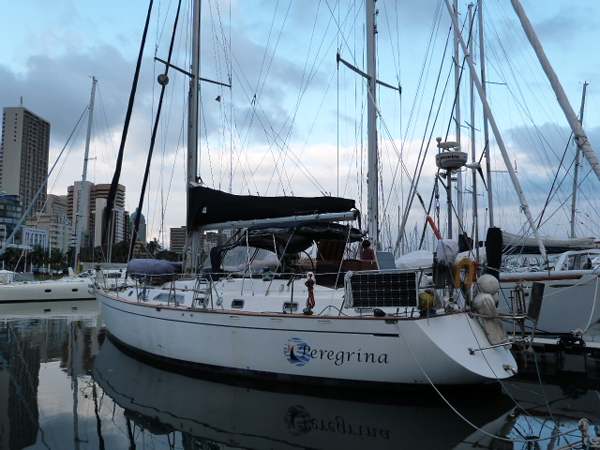
After many hours of preparation we felt that Peregrina was ready
for sea and we left Durban bound for Knysna, about 500 miles south.
While planning our route, I identified the very few safe
anchorages before reaching Knysna and other anchorages past Knysna, in case we
had couldn’t make our intended port of call. I also
plotted the waypoints in a hand held GPS in case we lost the main chart plotter
again. The west coast of Africa is tough sailing with little room
for forgiveness. I wanted to be
prepared.
But, it’s just not possible to sail the coastline in short daylight hops between anchorages. You must make extended overnight passages. What’s more, there are no islands to hide behind when the wind blows foul and very few harbors that can take deep draft sailboats like Peregrina which has a 6 ½ foot keel. It’s one of the most challenging areas to sail in the entire world.
Cruisers also must deal with the very strong Agulhas Current which runs down the southwest coast of Africa towards Cape Agulhas, near Cape Town. This current is great if you are going towards Cape Town, as we were, but terrible if you are headed the other way. We were told to stay near the 200 meters depth contour for maximum current and we tried to plot a course that would keep us in that vicinity. Before we knew it, we were racing along at an SOG (Speed Over Ground) of 10+ knots! A record speed for Peregrina!

But, the “flip side” of sailing in this thrilling current is
the threat of a “Buster.”A “Buster” occurs when the wind comes out of the southwest.
These winds are very high (35-50+ knots) and tend to “bust up” boats. The
danger with a “Buster” is wind against current. This means the wind, traveling
from the southwest to the northeast meets the Agulhas Current which is
traveling in the opposite direction. The wind pushes up the face of the waves
to enormous height. Many ships and men lie at the bottom of the sea attesting
to the danger of the African “Buster.”
The advice when a “Buster” comes through is to get out of the Agulhas Current and head towards shore – preferably a safe anchorage - wherever possible. This is difficult for a slow ocean going sailing vessel like Peregrina which averages only 5-6 knots under normal conditions. Since there are not a lot of accessible ports of call on this coastline, it can take days to get to a safe harbor.
But, all was going well. We had watched for a good “weather window” and were making our way nicely - along with help from the Agulhas Current.
Here, in the picture of the Chartplotter, you can see the
blue arrow of the current.
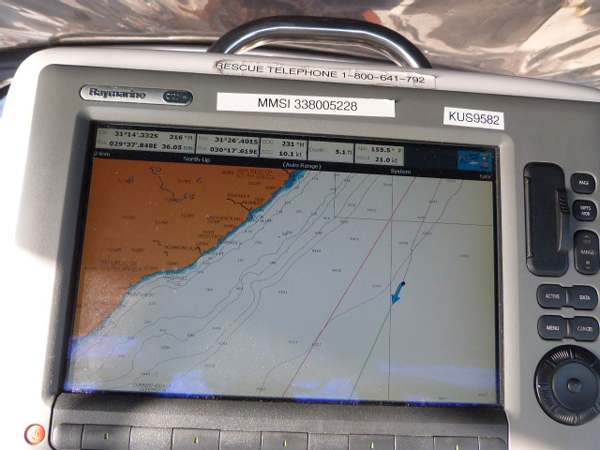

The width of the blue arrow indicates the velocity of the current.
For you nautical buffs, the current is calculated by subtracting our speed
through the water, provided by a little spinning paddle wheel located under the
boat, from our speed over the ground provided by the GPS Global Positioning
System.
Just before sundown, on the second night, we had winds from
the stern at about 25 knots. The boom was all the way out to starboard with a “preventer”
line tied from the end of the boom to the bow of the boat to prevent the
mainsail from an accidental jibe. The waves were also from the stern which
caused the boat to twist around from side to side and up and down. Not super
comfortable but not unsafe conditions.
Margie was below and I was on deck. I had my ear phones on
and was listening to a book about South Africa by Wilber Smith.
The BIG BANG was impossible to miss! Poseidon must have come down to wrench two pieces of metal apart. This was followed by a crashing sound on the deck which shook Peregrina to her core. Needless to say, it was time to stop listening to Wilber Smith!
Looking forward, I saw the metal boom vang which connects
the boom to the base of the mast swinging wildly and banging on the deck. The
boom vang is used when the wind is aft to keep the boom horizontal so that the
sail does not lift up. But here it was,
crashing around, having ripped off the aluminum contact point on the boom.
I flashbacked to an email I received just a couple weeks ago
from our friends in a Norwegian boat named HERO. Stein and Lovita and their young kids,
Magnus and Selma, had been making this same passage when their boom vang ripped
out, their mainsail lifted up, caught a spreader and ripped to pieces.
The memory of that email passed through my mind and I jumped
up and violently turned the boat into the wind to relieve the upward pressure
on the boom and the sail. Fortunately, our sail did not tear but, unfortunately,
the boom vang was still flailing around on the deck.
Margie came rushing up from below and, after assessing the situation, told me in no uncertain terms not to go on deck in those conditions. “Just leave it there” she said.
Well, you cannot leave a 7 foot long, 3 inch in diameter,
heavy metal pole bouncing around on the deck so, I grabbed the webbing tie-down
straps I keep in the cockpit (Yes, the same ones used to tie the boom to the
mast when the gooseneck broke during the Indian Ocean crossing) and secured the
boom vang to the deck.
But, that’s not all that needed jerry-rigging! On Peregrina, the boom vang actually has two
purposes. One is to hold the boom down when the wind is aft but the other is to
hold the boom UP so that, when we tack, the boom passes OVER the canvas Bimini top
above the cockpit and not THROUGH it! The
fact that the boom was now too low became apparent when I turned the boat into
the wind and the boom collided with the metal Bimini frame giving us another
jolt and threatening to knock the whole Bimini top off the boat!.
So I needed to rig a “topping lift” which is a line from the
top of the mast to the end of the boom.
This was a pretty tricky job since the end of the boom could not now be
centered over the boat. Thus, I had to
hang out over the water (Margie, holding on to the seat of my pants) attach the
line onto the end of the boom and winch it up.
After these projects were completed, we waited for the
weather to moderate a bit before removing the boom vang from the deck completely
and rigging a temporary 4:1 rope substitute.
Margie says I’m getting much too technical here for our friends who aren’t sailors and she’s convinced that our daughters are on the verge of deleting this posting for lack of interest so I better include some photos!
The following pictures, taken after the weather had moderated, show the boom vang on the deck, the broken metal and the rigging of a temporary substitute. To give you an idea of the length of the boom vang we later took a picture of Margie standing next to it. She is smiling for the camera but she was NOT smiling earlier when the boom vang broke!
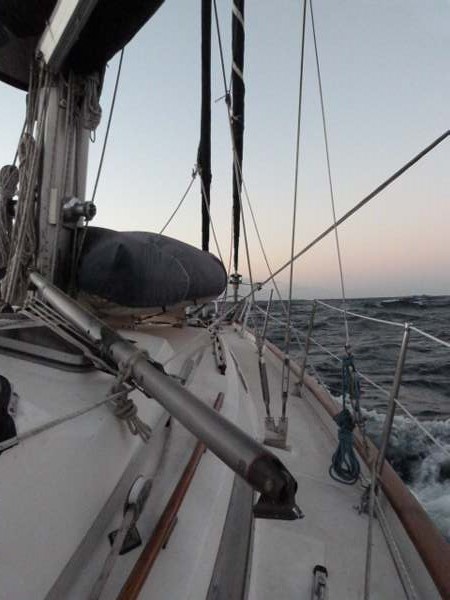
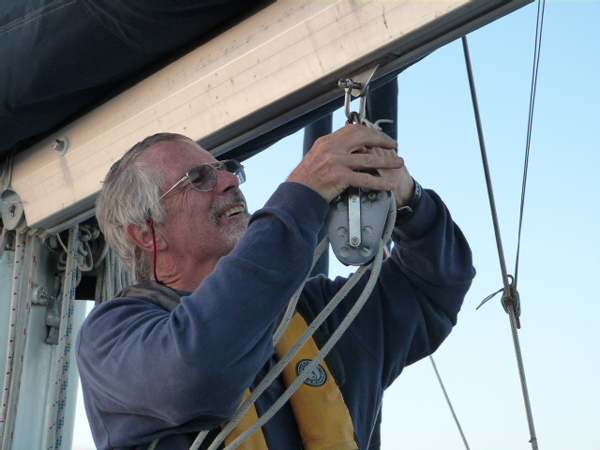
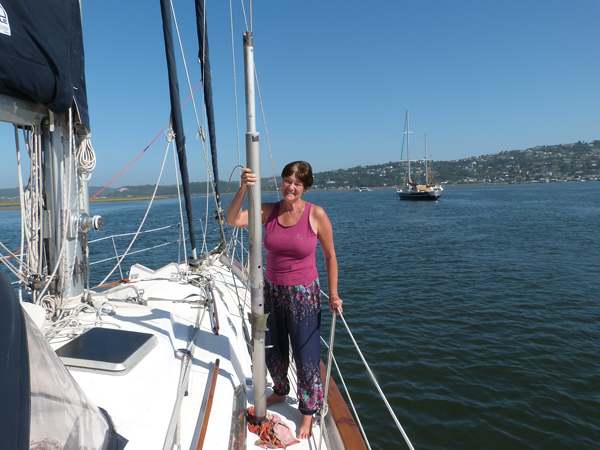
Life on board Peregrina went back to normal for another 24 hours until we approached our destination of Knysna. The Knysna lagoon has no commercial traffic since the lagoon is very shallow inside and the entrance is very narrow between two majestic promontory heads. The recommended time to enter is one hour before high tide to provide enough water under the keel and negate the tidal current that builds up in the large lagoon but must pass rapidly through the small opening at the Heads. The tidal current can run up to 7 knots at the passage.
The South African Nautical Almanac provides detailed sailing
information for the east coast of Africa. It says about Knysna.
“Because of heavy breakers across the Heads at times, it is not easy for low powered craft to maintain proper way in this channel. Without local knowledge the prudent advice is to attempt this entry only when conditions are fair. Several experienced people have lost their lives in this entrance.”
WOW … that’s quite a welcome message!
Now, our timing was great! It was just an hour before high
tide when the water should have been fairly slack but, wouldn’t you know it? As
we approached Knysna a series of rain squalls started coming through followed
by a heavy mist which reduced visibility. Margie wanted to continue on to Mossel
Bay, another port about 60 miles further down the coast. I felt it was
important to go in and check out the mast and boom for additional breakage and
structural weakness.
Below is a picture of the entrance which lies between the two “heads” of land. We apologize for the quality of the pictures but you are seeing what we were seeing. So, you can appreciate that Margie’s concerns were valid. But, as Margie puts it, I threw down the “Captain’s Card.”

The approach to the channel is determined by a combination
of strategies. First of all we used our
charts. But, we also listened for the
sounds of breaking waves, watched out for rocks and tried to follow the range
lights. A range consists of two lights positioned strategically on shore which
you line up, one above the other. When
you come in and can see both lights clearly in a straight line, you are on a
good approach. Unfortunately, that day, visibility was difficult and the range
lights were hard to see. In this photo you can see the one of the range lights which
was red in color. The other range light had disappeared in the rain.
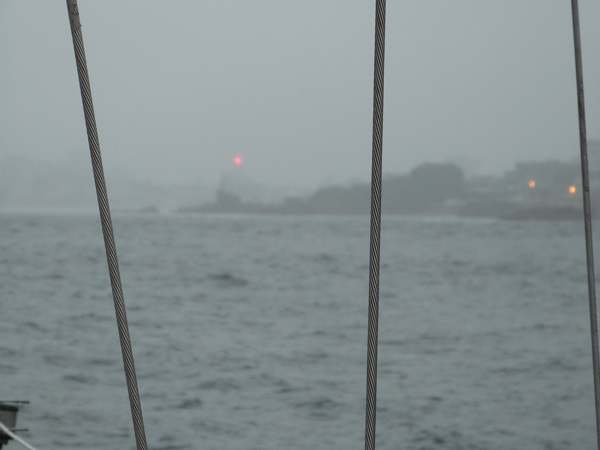
The channel is only about a hundred meters wide at best. You can see, by the look on my face, that it was not time to smile for the camera.
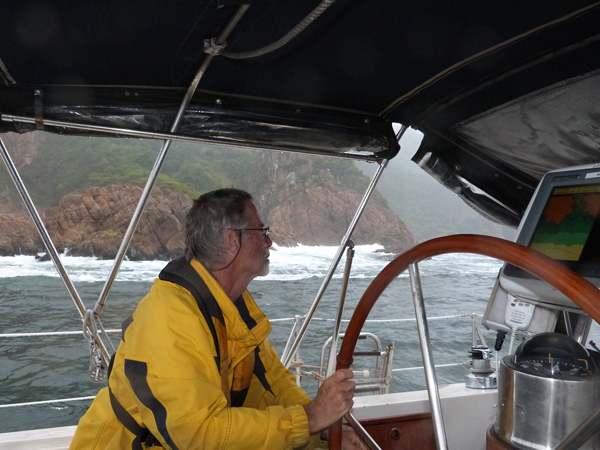
Here are the rocks next to us.
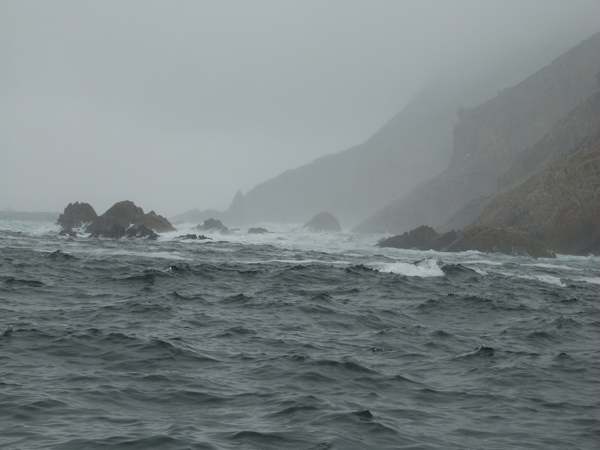
Well, since I am writing this you have figured out that we did get in fine and Knysna is a great lagoon, very protected. It has a wonderful yacht club with large fleets of small one-design sailboats racing every weekend. (Optimists, Lasers, 420’s, Hobie Cats etc…) We are enjoying our time here.
I guess we deserved a break …No! No! I meant a REST!